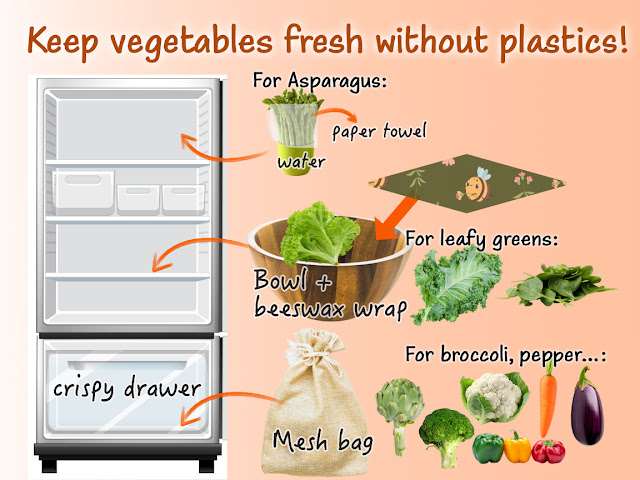Storing fruits and vegetables properly can extend their freshness, flavor and nutrition. Also we can reduce food waste. Here’s a comprehensive guide on how to store common fruits and vegetables without plastic bags. Using reusable bowls, jars, mesh bags and beeswax wrap works as well as disposable plastic bags and it doesn’t take much time from you.
Depending on their skin, fruit and vegetables have different ways of storing. To store produce right, the key is to prevent water moving away from the produce. Meanwhile, let go of unwanted moisture to avoid mildew to get on.
Fruits
- Apples:
It’s Ok for apples to stay in a cool, dark spot for 1-2 days . For longer storage, keep them in a bowl and cover by a lid in the fridge.
- Bananas:
first dissemble the bananas and keep them at a cool and dark spot.
- Citrus fruits (oranges, lemons, limes, grapefruits):
Store in a dry, cool and dark corner in a basket covered with newspaper.
- Melons:
Store uncut melons at room temperature.
- Watermelon:
Store whole at room temperature. Refrigerate after cutting.
- Peaches, plums, and nectarines:
Ripen at room temperature, then store in a mesh bag in the refrigerator.
- Pears:
Ripen at room temperature, then refrigerate in a mesh bag.
- Pineapple:
Store at room temperature if using soon. Refrigerate for longer storage.
- Avocados:
Ripen at room temperature. Store in the refrigerator when ripe to slow further ripening.
- Blueberries:
Store in a jar covered by beeswax wrap in the refrigerator. Also for cranberries and strawberries.
- Grapes:
Store in a bowl covered by a lid in the refrigerator.
Vegetables
- Asparagus:
Trim the ends, place upright in a glass of water. Cover the top with a paper towel. Reuse the paper towel while cooking.
- Broccoli and cauliflower:
Store in a mesh bag and place it in the crispy drawer of the refrigerator.
- Artichoke:
Store in a mesh bag and place it in the crispy drawer of the refrigerator.
- Celery and cucumber:
Trim and store in a jar in the refrigerator.
- Eggplants, and peppers:
Store in a mesh bag in the crisper drawer of the refrigerator.
- Leafy greens (lettuce, spinach, kale):
Store in a covered mixing bowl in the refrigerator. Cover with a beeswax wrap.
- Mushrooms:
Store in the refrigerator in a jar covered by beeswax wrap.
- Onions and garlic:
Store in a cool, dark, and dry place with good air circulation. Do not refrigerate.
- Potatoes and sweet potatoes:
Store in a cool, dark, and dry place. Avoid refrigerating, which can change their taste.
- Squash and pumpkins:
Store in a cool, dark place for short-term storage. For more than a week, keep in a cool, dry place.
- Tomatoes:
Ripen at room temperature, away from direct sunlight. Refrigerate only if overripe to extend life for a few days.
- Zucchini and summer squash:
Store in the mesh bag in the crisper drawer of the refrigerator.
General Tips
- Do not wash fruits and vegetables until you're ready to use them to prevent mold and bacteria growth.
- Keep fruits and vegetables separate, as fruits tend to emit ethylene gas that can speed up the ripening process of vegetables.
- Storing fruits and vegetables correctly not only extends their shelf life but also maintains their taste and nutritional value. Waste less and save money.








0 Comments